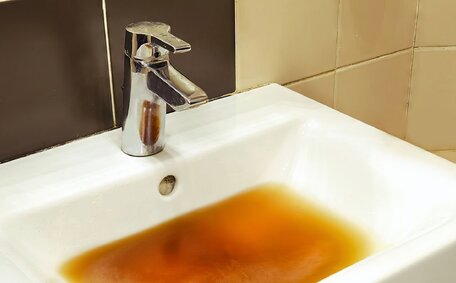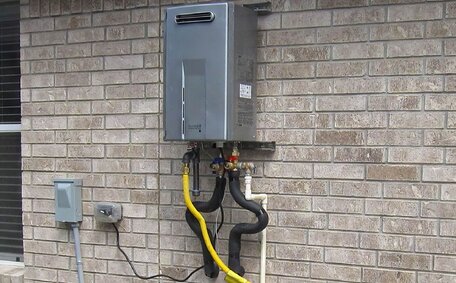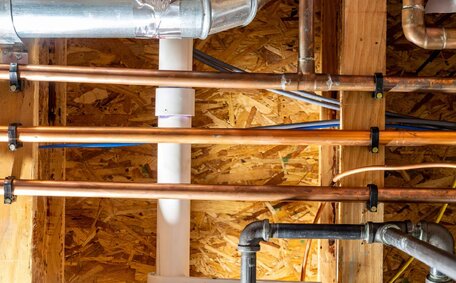Understanding Your Hot Water System
An effective hot water system is essential for household comfort and energy efficiency. Hot water usage contributes significantly to the average Australian home’s energy consumption, so it’s key to understand how your system works and how to optimise its performance.
A typical system consists of a hot water heater or boiler, pipes and thermostatic valves. Water is heated and stored in an insulated tank or it runs through a continuous flow heater as needed. Thermostats can do the job of controlling the water temperature by signalling the heating elements to switch on or off.
For storage systems, the optimal thermostat setting is at least 60 degrees Celsius to prevent Legionella bacteria growth, but setting it higher than 60°C is unnecessary as it simply wastes energy cooling water down before use.
A continuous flow system works best around 50°C. The key is insulating pipes properly and adjusting your thermostat to the most efficient temperature that meets your household’s hot water needs.
Storage vs Continuous Flow Systems
There are two main types of hot water systems used in most Australian households - storage tanks and continuous flow heaters.
Storage Systems: These consist of an insulated tank that heats and stores a set amount of hot water. Cold water is drawn into the bottom of the tank and heated by gas or electric elements, regulated by the thermostat.
The advantages include reduced operating costs and meeting high usage needs, whereas drawbacks encompass standby heat losses and the requirement for greater installation space.
Continuous Flow: These heat water directly as it passes through the flow system, so there is no tank. The compact size allows flexible placement, but you might find the flow rates limited, so they may struggle to meet high demand. Operating costs tend to be higher as well.
Key differences come down to upfront costs, energy efficiency, flow rate and size. Storage tanks suit larger families with fluctuating usage, while continuous flow works well for 1-2 people with consistent daily needs. But both can provide reliable hot water when maintained properly and operated at optimal temperatures.
Optimal Temperature Settings
When it comes to thermostat settings, the optimal temperature depends on your hot water system type.
Storage Tanks: Set your storage tank to a safe 60-65°C to prevent Legionella bacteria proliferation, without exceeding 65°C to avoid energy waste from excessive cooling.
Continuous Flow: A continuous flow system should set around 45-50°C for optimal performance. Temperatures exceeding 50°C can compromise these systems’ efficiency and functionality.
Regardless of system type, make sure your thermostat allows water to reach at least 60°C during its heating cycle to kill bacteria. This principle is equally relevant to electric storage models with integrated thermostats that do not show exact temperatures.
Achieving a balance between safety and efficiency may require some experimentation. Begin with a setting below your current one to prevent excessive heating and observe your hot water needs over a couple of weeks. If you find yourself running out too quickly, incrementally increase the temperature setting until you find the sweet spot.
Preventing Bacteria Growth
One key risk with hot water systems is potential bacteria growth, particularly Legionella. Legionella bacteria can proliferate quickly in water temperatures ranging from 20-45°C, causing health risks through the inhalation of contaminated water vapour and droplets.
Setting your thermostat to at least 60°C ensures stored water is heated sufficiently to kill bacteria during the cycle. For continuous flow systems that don’t store water, aim for 50°C minimum to mitigate risk as water passes through heating elements.
Additional measures for safe operation include:
- Annual inspections of tank condition and temperature settings
- Regular draining of sediment which can harbour bacteria
- Insulating tanks and pipes is critical, as bacteria thrive at 20-50°C and insulation helps retain heat.
- Installing temperature limiting valves or tempering valves to prevent scalding
Proper insulation and thermostat management to maintain optimal temperatures not only prevents Legionella overgrowth, but maximises energy efficiency too.
Avoiding Scalding & Saving Energy
Having your hot water system thermostat set too high increases the risk of scalding and wastes energy. Water heated above 50°C can cause serious burns and also result in a significant amount of energy wasted. Fitting tempering or mixing valves by basins and showers conserves energy and helps prevent scalding.
To conserve energy, maintain your storage tank at 60-65°C and continuous flow systems at no more than 50°C. Reducing your thermostat setting by 5°C can cut energy costs by 4-10%. So dropping a 75°C system down to 60°C could reduce your home’s energy usage by up to 20%.
Other tips include insulating exposed hot water pipes to minimise surface heat loss, fitting water efficient showerheads, fixing any leaks promptly and installing insulation blankets or shells around older systems.
Insulating Tanks & Pipes
Insulating your hot water system’s tank and pipes effectively reduces energy consumption. Insulation for tanks reduces standby heat loss, and insulating pipes inhibits heat from dissipating along their surfaces.
For storage tanks, installing a quality insulation blanket around the exterior can reduce standby energy losses by 25-45%. Opt for an insulation rating of R2.5 or higher for optimal savings. Ensure the insulated pipes have a minimum rating of R1 for efficiency.
By increasing thermal efficiency from insulation, you ensure the energy your hot water system uses is maximised, cutting an average household’s bills by around $100 per year. And by retaining more heat energy, your system won’t need to work as hard to maintain the thermostat temperature setting. This saves you additional energy as you cut back over time.
Other benefits of insulation include:
- Lower greenhouse gas emissions
- Enhanced safety - surface temperatures are reduced, lessening burn risk
- Greater hot water capacity and flow rate
- Extended system lifespan with less wear on heating elements
Given typical installation expenses between AUD 150-350, an insulation enhancement can recoup its cost within 1-3 years via energy savings. Just remember to inspect any tank insulation annually for moisture damage or gaps.
Installing Water Saving Fixtures
Installing water efficient fixtures is another great way to enhance the efficiency of your hot water system and conserve energy.
Showerheads with a low flow rate, under 9 litres per minute, conserve water whilst maintaining adequate pressure. Pairing water efficient taps and aerators on basins and sinks with a low-flow showerhead can reduce hot water usage by 35% or more.
Thermostatic mixing valves, also known as tempering valves, mix hot water with cold to safely deliver water at a preset temperature to fixtures. This provides temperature control to prevent scalding, while allowing the tank or boiler thermostat to be set higher for optimal heating efficiency.
Anti-convection valves can be installed on the hot water line near fixtures prone to waste heat through convection. These one-way valves stop warmer water rising and cooler water falling within pipes when the tap is off, reducing standby losses.
Altogether, installing some water efficient fixtures alongside better insulation and an adjustable thermostat can cut the average household’s hot water-related energy usage by 50% or more. Therefore, modest system enhancements and careful monitoring of your hot water usage can significantly amplify your water and energy savings.
Performing Regular Maintenance
Routine maintenance is crucial for any hot water system to operate safely and efficiently long-term. An annual service check by a licenced plumber can identify and replace worn parts before they fail.
Key maintenance tasks include:
- Inspecting system components like heating elements, anodes and valves
- Checking and adjusting thermostat settings
- Clearing sediment from the tank bottom
- Testing temperature and pressure relief valve functionality
- Flushing heat exchanger coils in continuous flow models
Preventative maintenance lets you detect leaks, corrosion, blockages or overheating risks early. It also keeps your system performing optimally for energy efficiency. Adjustments during servicing coupled with updates like low-flow fixtures improve efficiency further still.
While the annual service cost may seem unnecessary, it saves money over time by preventing costly emergency callouts for faulty heaters. And with potential Legionella risks, you can rest assured your system operates safely for your family.
Adjusting Thermostat Settings
If you have a storage tank system, modifying the thermostat setting is usually uncomplicated. Follow these steps:
- Locate the access panel on your storage tank and switch off the power supply.
- Open the panel to find the thermostat dial or digital thermostat for models operating at higher temperatures, which you can then adjust.
- Check the current temperature setting and adjust downwards towards 60°C if it’s set much higher.
- For gas storage heaters, lighting instructions are often printed nearby. Re-light your system’s pilot light if needed.
- Close up the access panel and switch power back on.
- Verify the water temperature at taps post-heating cycle is at least 60°C, and make any necessary adjustments.
- Make small 5 degree adjustments and retest until you find the optimal setting that works for your household needs.
Refer to your continuous flow system’s user manual to make temperature adjustments. Reducing the operating temperature by 5 degrees can lead to energy bill savings over time.
Most have a small dial underneath or a temperature limiting stop valve fitted on the outlet set to 50°C max.
Selecting the Appropriate Hot Water System
When selecting a new hot water system, the optimal choice depends on your household size and hot water usage patterns. Larger capacity storage tanks are well-suited for bigger households with variable hot water demands. Continuous flow systems suit 1-2 occupants with consistent hot water requirements.
Also factor in upfront system costs and operating expenses in the long run. Storage heaters often carry a higher initial price tag but can have lower ongoing energy bills. Insulation levels, climate and installation complexity should be weighed up too.
In warmer climates, such as Vaucluse, lower standby heat losses from storage tank water heaters make them an efficient choice for many households.






